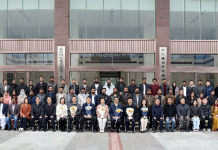
By Li Ya’nan, Yang Shuobi, Xiang Zifeng, People’s Daily
China’s Xinjiang Uygur autonomous region is working to build itself into a beautiful Xinjiang that is united, harmonious, prosperous, and culturally advanced, with healthy ecosystems and people living and working in contentment. Today, China-Europe freight trains are running across this important node along the Silk Road, constantly releasing development potential; the autonomous region’s economic structure is continuously optimized with upgrading traditional industries and new emerging sectors; the prospering green industries are taking the economic development onto a new level.
In Sangong township, Huocheng county, Ili Kazakh autonomous prefecture of Xinjiang, stevia plants were thriving along a national highway. These plants have seen a remarkable price increase, soaring from just over 10 yuan ($1.37) per kilogram to nearly 300 yuan.
In a workshop of a Xinjiang-based biotech firm, a production line of stevia leaf purification was running at full capacity. Zhou Meng, chairman of the company, told People’s Daily that stevia leaf is a natural and high-quality sweetener, which is 300 to 400 times sweeter than sucrose, but its calorie is only 1/300 of white sugar.
Stevioside extracted from stevia leaves is widely used in the pharmaceutical and food industries.
The biotech firm is a key technological innovation company in Xinjiang. So far, the company has built two production lines for stevioside and has a complete set of supporting equipment.
Flower-related industries covering lavender, rose and peony are continuously expanding in Xinjiang, increasing the income for local residents.
In Ma Zhongliang’s shop in Sigong village, Lucaogou township, Huocheng county, various lavender processed products were neatly displayed on shelves, including essential oils, dried flowers, and pillows.
In 2010, Sigong village started developing the lavender industry, established a specialized cooperative, and introduced essential oil processing enterprises. Gradually, a distinctive industry chain was formed, covering lavender cultivation, development, sales, and the recycling of lavender straws. Over 300 local farmers transformed from “farmers” to “merchants.”
With the continuous increase in the added value of lavender, in 2022, the per capita income of villagers in 718 households reached 22,000 yuan, approximately 2,000 yuan higher than the per capita income of the entire township.
In a vegetable packaging workshop of a trading company in Xinjiang’s Tacheng, fresh vegetables such as bell peppers, cucumbers, and tomatoes were being loaded onto trucks. The freshly picked vegetables could make their way to the dining tables of Kazakh families the next day.
According to Yu Xinli, manager of the company who has been engaged in fruit and vegetable foreign trade for over 20 years, the company exports an average of about 80,000 tons of fruits and vegetables from the Baketu Port in Tacheng every year. About 40 percent of goods are local sources, bringing benefits to local farmers.
“We have two harvests in a year, and the earnings from each mu of greenhouse can reach 50,000 yuan,” he said.
The increased income comes from opening up. In December 2013, the Baketu Port, which is just 12 kilometers away from downtown Tacheng, opened the country’s first “green channel” specifically for the quick customs clearance of agricultural and sideline products. Since then, the clearance process has become much faster.
“There is almost no need to wait,” Yu said.
On May 18, the number of inbound and outbound freight vehicles at the Horgos highway port, Ili Kazakh autonomous prefecture, exceeded 1,000 for the first time, reaching 1,099. The figure was less than 300 in 2019.
Ports in Xinjiang are always kept busy by China-Europe freight trains and cargo trucks fully loaded with containers, which is a miniature of the autonomous region’s ongoing efforts to expand its opening up.
According to statistics, the total value of foreign trade in Xinjiang reached a staggering 183.16 billion yuan in the first seven months of this year, an increase of 59.3 percent over the same period last year.
Along a road on the outskirts of the Taklamakan Desert, rows of solar panels were glistening, bringing new hopes to the autonomous region.
In a photovoltaic power station run by State Power Investment Corporation in Luopu county, Hotan, a leader of an installation team was busy inspecting solar panels. This year, he led some 20 villagers to install solar panels for the power station, and each one of them could earn an average of approximately 10,000 yuan a month.
As the largest new energy power generation project in Hotan, it is expected that the annual average power generation of this photovoltaic power station can reach 360 million kilowatt-hours. During the construction period, the power station employed about 1,500 workers, of which 1,000 were local people in Lopu county.
Xinjiang’s arid and sunny climate with strong winds and sandstorms has become a driving force for the green transformation in the autonomous region. By improving the energy structure and introducing green and low-carbon industries, Xinjiang’s new energy industry has taken new steps towards high-quality development.
In 2010, Xinjiang had no photovoltaic power generation and the installed capacity of wind power was only 1 million kilowatts. Through continuous development, as of mid-July this year, Xinjiang’s installed capacity of new energy had exceeded 50 million kilowatts, accounting for over 40 percent of the total installed capacity.
According to estimation, by 2025, Xinjiang’s total installed capacity of grid-connected new energy is expected to exceed 116 million kilowatts, with wind and solar power projects becoming the main source of new installed capacity. This will inject new momentum into economic growth and the achievement of the “dual carbon” goal.





